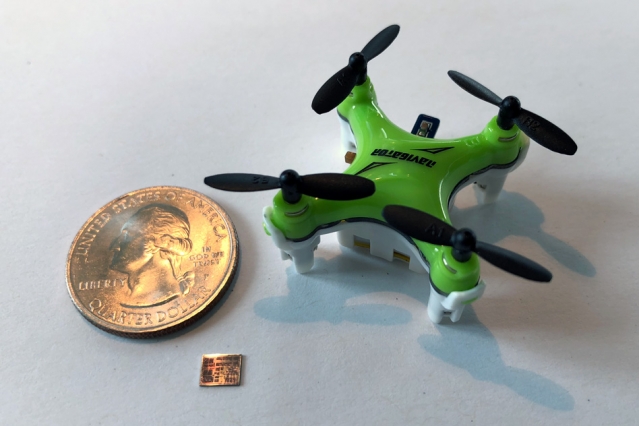
© Image courtesy of the researchers MIT
Last year, researchers at MIT created a miniature computer chip designed to help bug sized drones fly. Now, they have reduced the size of the chip and its power consumption even further. Associate professor, Vivienne Sze, at MIT’s Department of Electrical Engineering and Computer Science (EECS) and her team have created an innovative new chip that is built around the concept of low power consumption in a compacy size while also having an increased processing speed.
Navion is the name of the chip and it measures only 20 square millimeters, which is smaller than a stamp and only uses about 24 milliwatts of power. With such a tiny energy footprint, the Navion chip can process camera images in real time at about 170 frames per second. The researchers stated that it can be installed into “nano-drones” as small as a fingernail, which will be ideal for remote or inaccessible areas where GPS data is unavailable.
In the past few years, several researchers have developed miniature drones so small they could fit in the palm of your hand. Scientists are excited for the day when these tiny drones can fly around and take pictures of the environment as well as being sent out on specialty missions. But the problem has always been the power source. Small sized drones can carry just enough battery power for flight, leaving only a little energy for other operations like navigation and photography.
Researchers have begun to address these issues by using several algorithms and hardware combined into a single microchip. The Sze team at MIT created an initial design that was implemented on a commercial platform known as FPGA. The chip did some calculations while only consuming about 2 watts of power, which is low when compared to larger drones that usually need up to 30 watts to carry out the same tasks.
The team decided to shrink the chip even further, in both power consumption and size by building a new chip from the ground up. To reduce the power consumption of the chip even further, they decided to use a new design to reduce the amount of data produced and stored on the chip. This miniaturization was used to enhance the way data is processed by the chip. They also reduced the chip’s memory from 2mb to about 0.8mb. The new chip was tested and was successful and proved that power consumption had been reduced from 2 watts to 24 milliwatts. With the new drone technology combining reduced power consumption and physical size, there will be a many uses in many industries throughout the world that can benefit from these miniature drones from search and rescue missions, to photography, mapping and much more.
|